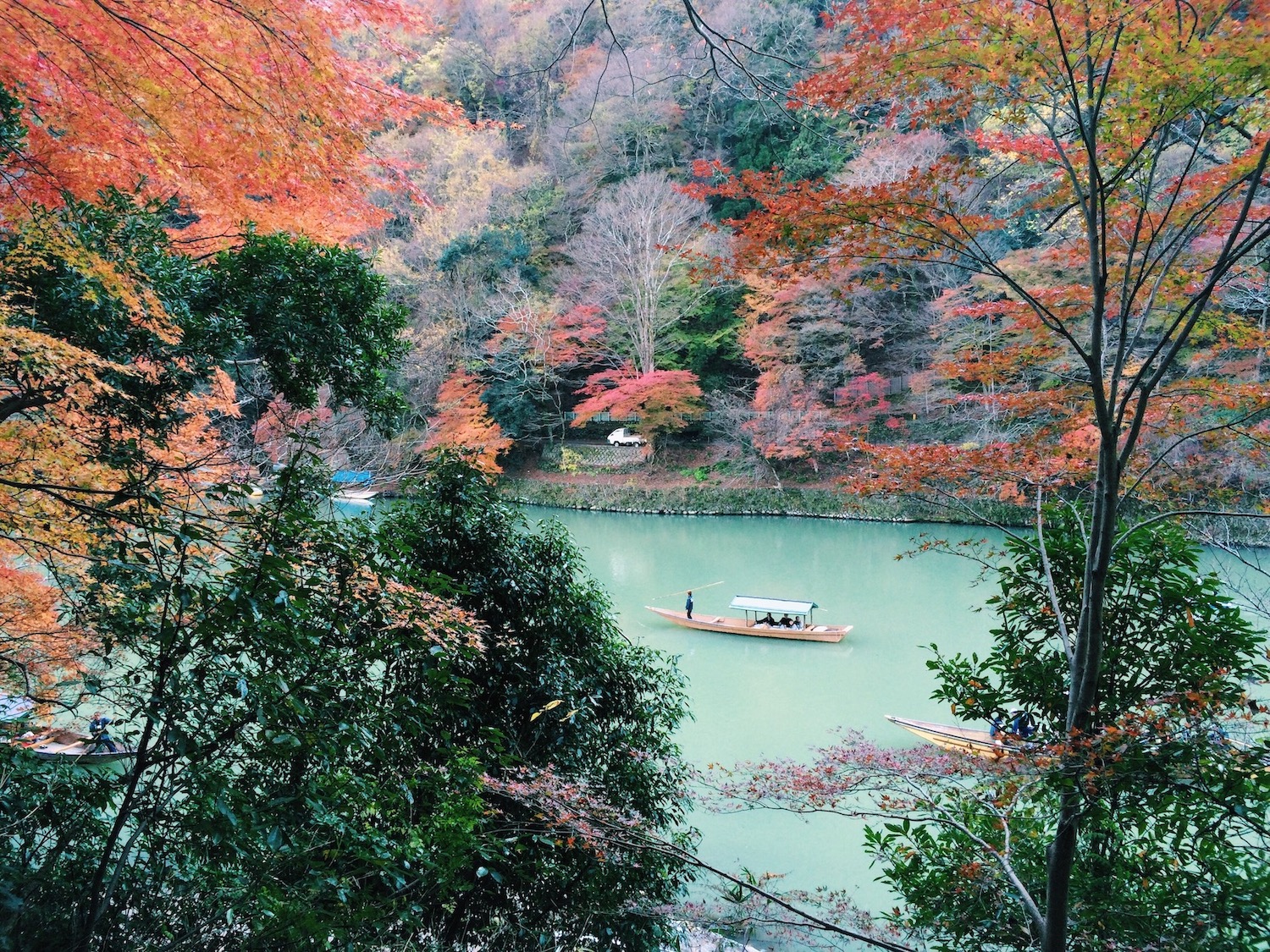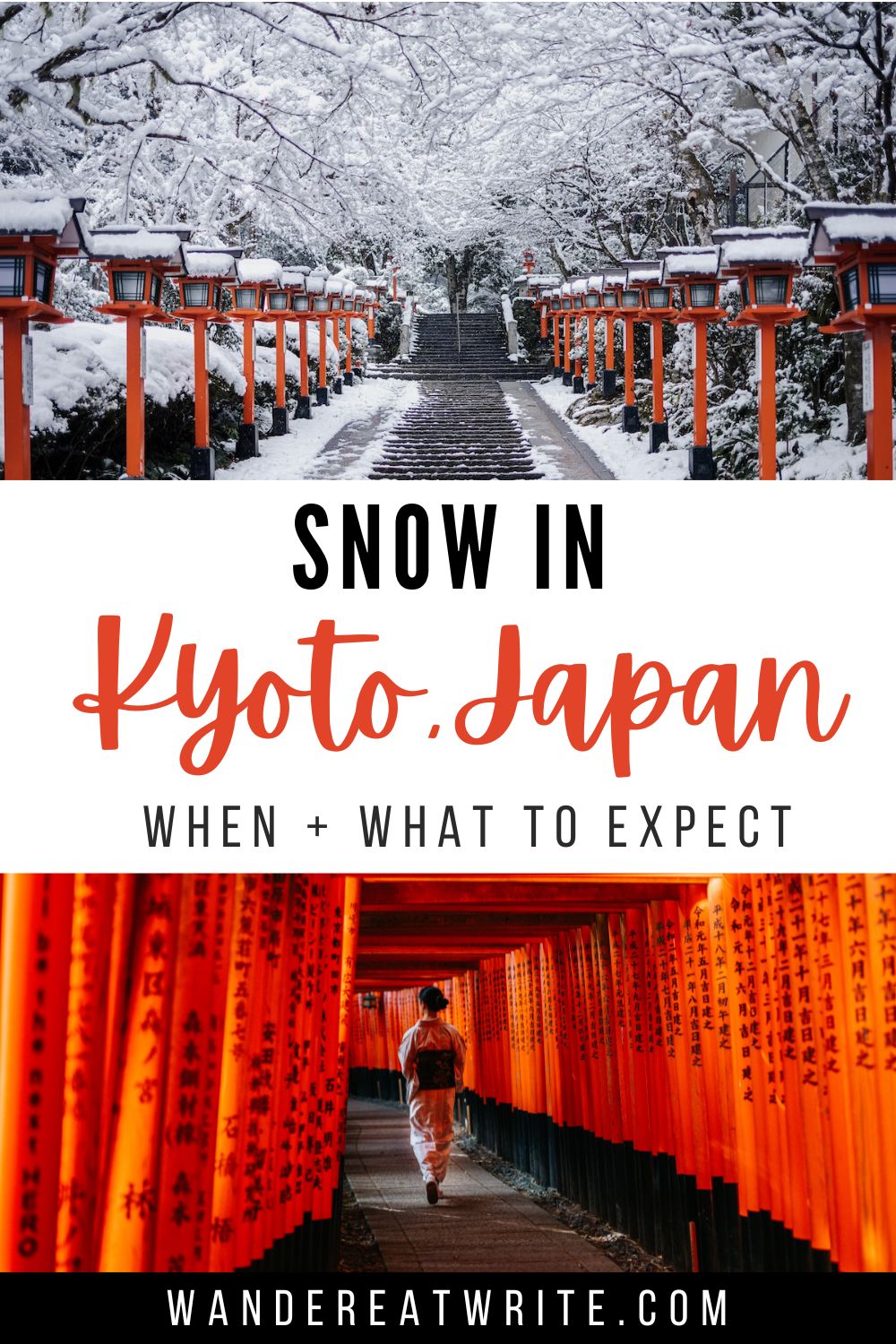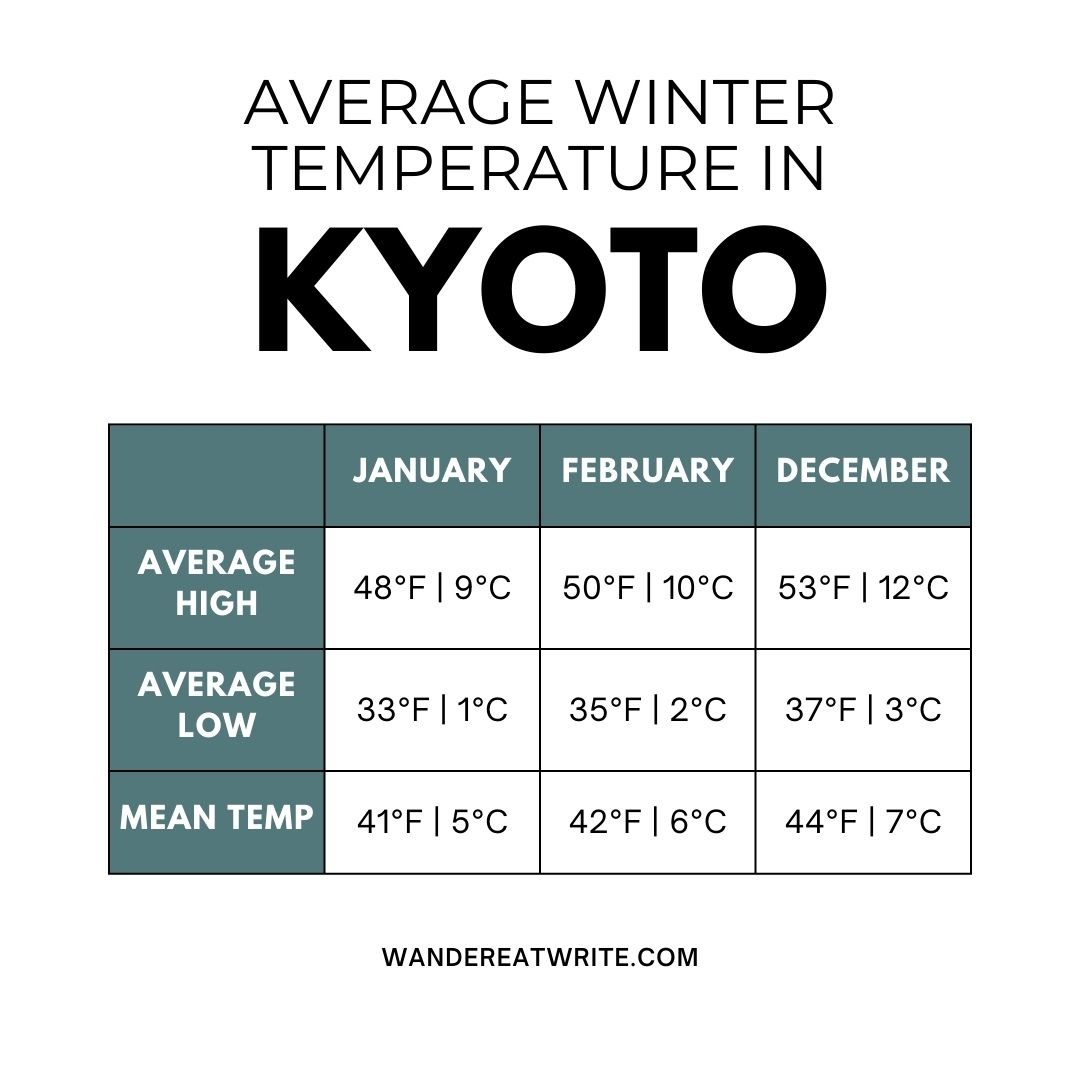
Does it snow in Kyoto?
This is a question I had before moving to Japan.
Now, as a former Japanese resident who’s explored Kyoto in every season, I’ve got all the answers you’re looking for.
This post covers when and how much snow to expect in Kyoto, how cold it gets in the winter, and the top things to do during Kyoto winters.
Does It Snow in Kyoto?
The short answer: Yes, it does snow in Kyoto in the winter.
Compared to snow in Tokyo, you’re more likely to experience snowfall in Kyoto, especially in January.
Winter in Kyoto can vary from season to season, with some winters seeing as little as 1 cm or less than an inch of snow and other winters getting as much as 28 cm (11 in).

Does It Snow in Kyoto in December?
It does snow in Kyoto in December sometimes.
However, in the last decade, it has only snowed in Kyoto in three out of ten Decembers.
If your Japan visit is in December in Kyoto and there is snowfall, it won’t be more than 4 days with an average depth of 3 cm (1 in) as this is the first month of winter.
When Does It Snow in Kyoto?
So when does it snow in Kyoto the most?
Kyoto snow days are typically highest in January, with an average of 9.9 snowfall days.
In the last 10 years, Kyoto has seen snow in eight Januarys with snowfall ranging between 1-35 cm (0.5-14 in).
There are approximately 7.8 days of snow in February, though some winters don’t see any snow at all.
Kyoto still experiences some winter weather in March as it transitions to spring with the possibility of light snowfall, though the last time it snowed in Kyoto in March was 2016 (and only 1 cm, or less than half an inch).
How Often Does Kyoto Snow?
In the winter, Kyoto may see up to 16-21 days of snow with January having the most snowfall days.
Winter in Kyoto
Winter in Kyoto is from December to February with March also experiencing colder temperatures for most of the month.
While there is light snowfall in January, Kyoto winters are the driest season in terms of rain.
Visitors can expect mostly overcast skies in the winter with four hours of sunshine per day.
Overall, Kyoto weather during the colder months is still quite pleasant and comfortable for sightseeing.

How Cold Does It Get In Kyoto?
Kyoto in the winter is generally colder than Tokyo due to its location in a basin surrounded by mountains.
However, Kyoto temperatures in winter are still relatively mild compared to northern Japan.
If you live in an area where you regularly experience freezing temperatures (like when I worked in Antarctica!), a Kyoto winter will be more than bearable.
In the winter, expect temperatures in Kyoto to be around 41°F-44°F (5°C-7°C).
Evenings will be cooler with temperatures dropping as low as 33°F (1°C) and daytime highs can reach up to 53°F (12°C).
It’s not life at the South Pole, but it can get chilly.
Here are the average winter temperatures for reference:
Things to Do in Kyoto in Winter
Fortunately, there are plenty of things to do in Kyoto in winter.
You can still visit all of the main sightseeing spots even when it snows.
In fact, the top Kyoto attractions like shrines and Arashiyama (bamboo forest) will look like a dreamy fairytale in snow.
1. Experience a Traditional Tea Ceremony
Kyoto is all about tradition, and what’s better than experiencing it firsthand in a tea ceremony?
In this tour, you’ll watch a tea master prepare the perfect bowl of matcha, then brew your own while you take it all in in a beautiful Japanese garden.
This tea ceremony also takes place indoors, so rain, shine, or snow– you’ll be plenty warm and cozy!
You’ll have plenty of opportunities to take photos to post along with your best Japan captions.
2. Check Out Winter Illuminations
One of my favorite things about winters in Japan is that they get lit– literally.
Every city has streets, trees, department stores, and public spaces illuminated with fairy lights.
There are also exhibits and events where parks are transformed into sparkling winter wonderlands after dark.
Visiting different cities to see their light shows and decorations was one of the best parts of getting paid to live in Japan during the winter.
Some cities even have illuminations up past winter and into the early spring, so if you’re visiting Japan for cherry blossom season, you might get some overlap.
Kyoto has a few notable winter illumination displays worth checking out and adding to your Kyoto in winter itinerary:
- Kyoto Station
- Arashiyama Hanatouro
- NAKED’s Garden of Japanese Lights at Heian Jingu Shrine
- Bambio Square Park, Nagaokakyo

3. Visit an Onsen
Visiting an onsen, or hot spring, in Kyoto during winter is like giving yourself a warm hug from the inside out.
There’s nothing quite like soaking in a hot spring bath while surrounded by snow and nature.
Plus, it’s a perfect way to unwind after a day of exploring and soothe those tired muscles.
An onsen is definitely one of the best places to visit in Kyoto during winter.
Here are some of the top onsen in Kyoto:
- Kurama Onsen
- Funaoka Onsen
- Tenzan no yu
- Arashiyama Onsen Saishiki no Yado Hanaikada
- Tensho no yu
4. Taste Seasonal Cuisine
Japan is all about celebrating seasonal changes, especially the food.
Be sure to indulge in some of the most popular Japanese food winter dishes to stay warm, like oden or shabu shabu.
Those visiting during the New Year holiday can also try osechi.
If you can’t get enough of Japan’s seasonal treats, you can subscribe to monthly snack boxes for a taste of Japan at home.
You can read my review of Sakuraco and Tokyo Treat, two of the most popular Japanese snack boxes.
I’ve also got a Sakuraco vs Tokyo Treat review comparing the two options.
Read More: Sakuraco vs Tokyo Treat [2024]: What’s the Difference?

5. Learn How to Make Ramen
Take a piece of Japan home with you when you learn how to make ramen at the Ramen Factory.
In this workshop, you’ll make your own noodles from scratch then create your ideal ramen (miso, salt, or soy).
You’ll get a souvenir to take home, as well as the recipe so that you can re-create the experience back home.
And the best part?
Getting to eat the fruits of your labor, of course!
After all, there’s nothing like a hot bowl of noodles to warm you up on a cold, winter day.
6. Get Lost in Arashiyama Bamboo Forest
Arashiyama in winter can be magical, especially with a dusting of snow.
The famous bamboo forest in Kyoto is worth visiting in any season, but may be less crowded in winter, which is a big plus.
You can easily spend a few hours getting lost in the main grove as well as exploring the surrounding area and river.
While Japanese Valentine’s Day is celebrated a little differently than in the Western world, Arashiyama still makes for a romantic date if you’re in Japan on February 14th.
7. Climb Fushimi Inari Taisha
A pilgrimage to Fushimi Inari Taisha is a must any Kyoto winter itinerary.
While the endless steps may seem daunting, the cooler temperatures will make the hike up more bearable than in the sweltering summer heat.
Those who aren’t fans of crowded tourist spots will also be happy to know that typically only the first bit of the climb is the busy section.
Every time I’ve visited Fushimi Inari, the crowd thins out once you get past the main lower section.
You can also go first thing in the morning to avoid crowds even further.

8. See Kinkakuji Golden Pavillion
Visiting Kinkakuji Golden Pavilion in winter is like stepping into a serene, snow-globe world.
The gold leaf-covered pavilion contrasts beautifully against the white snow, making it an absolute must-see.
Despite seeing the pavilion a handful of times, I’m still drawn to visit every time I’m back in town because of how mesmerisingly stunning it is.
Between the gorgeous architecture, the glittering gold, and the reflection from the water– it’s pure perfection.
9. Relax in a Zen Garden
Stop by Ryoanji Temple to see the famous rock zen garden.
One of the beautiful things about Japanese culture is its appreciation of simplicity, like creating a garden out of just rocks and nothing else.
No flowers or foliage mean even this zen garden is just as beautiful in the winter.
The rest of the temple grounds and park offer tranquil vibes that you can take in leisurely while de-stressing.

10. Take a Night Walking Tour of Gion Geisha District
No trip to Kyoto is complete without a visit to Gion, the old geisha district.
In this walking tour after dark, you’ll explore the iconic narrow alleyways and see the town come to life after sunset.
You’ll see geisha and maiko as you’re guided to Yasaka Shrine and walk along Hanamikoji Street.
What to Pack for Kyoto in Winter
Planning your Japan winter clothes is actually quite simple; the key is layers.
This is something you learn quickly when you live in Japan!
When you’re visiting Kyoto attractions in winter, outdoor temperatures may be chilly but indoors and public transportation will be heated and warm.
You can check out my full guide on what to pack for winter in Japan.
Here are the layering basics to pack for Kyoto in winter along with other essentials:
▶️ Inner Layers: HeatTech/thermal shirts, t-shirts, lined tights/leggings
▶️ Mid Layers: Sweaters/long sleeve button downs
▶️ Outer Layer: Packable parka/long coat, dresses, trousers, jeans
▶️ Accessories: Beanie, scarf, gloves (all optional but helpful)
▶️ Socks: Crew length and/or wool is best for warmth and moisture-wicking
▶️ Shoes: Good walking shoes and/or water-resistant boots
▶️ Day bag: Packable backpack or half-moon bag
▶️ Electronics: Universal adapter, portable charger
See my winter packing list for Japan here

How to Pack Light for a Japan Trip
If you’re looking for tips on how to pack light, I’m your girl!
I’ve lived out of a suitcase for over a decade by finding travel jobs that don’t require experience and often only travel with a carry-on or just a personal item for two-week trips.
You can see how I pack for a 7-day Caribbean cruise with carry-on only as well as a two-week trip to San Francisco with a personal item-sized backpack.
When I lived in Japan, I often traveled around the country with just a backpack too as it was so much easier to get around without a suitcase.
It’s completely doable even in the winter.
You just have to be smart about your packing list.
Here are my top tips:
💡 Stick to no more than two color palettes.
This way all your clothing works with each other no matter the outfit combo.
💡 Don’t pack a specific airplane outfit.
Make sure you can wear your outfit throughout your trip, not just the long-haul flight.
💡 Bring no more than two pairs of shoes.
Wear the biggest/heaviest when traveling.
💡 Plan on doing laundry every few days.
This can be either handwashing in the sink or shower, or utilizing the hotel/Airbnb’s laundry machines.
💡 Bring clothing made from Merino wool.
It’s lightweight but keeps you warm and has natural odor-resistant properties which means you can wear your clothing multiple times before needing to wash away smells.
You can read my Unbound Merino review for more details.
Read More: Unbound Merino Review: Your One-Bag Travel Bestie

Where to Stay in Kyoto
In such a historic city, there are so many options for where to stay in Kyoto.
These range from traditional Japanese-style guesthouses to futuristic capsule pods.
Best Budget: Hotel M’s Est Shijo Karasuma
Don’t let the term “budget hotel” fool you.
While this might mean a 2-star hotel in the US for $100 a night, a budget hotel in Japan might as well be a 3- or even 4-star hotel in the States.
Hotel M’s Est Shijo Karasuma is a clean and comfortable stay with economy double rooms as low as $50.
The layout is efficiently designed in true Japanese fashion, with shelves and desks built into the wall to save space.
The hotel is just a minute’s walk from the subway station with restaurants and cafes within a 5-minute walk, making a stay at Hotel M’s so convenient.
➡️ CHECK PRICES & AVAILABILITY: HOTEL M’S EST SHIJO KARASUMA
Best Capsule Hotel: The Millennials Kyoto
Spending a night in a capsule hotel is a must when visiting Japan.
The Millennials Kyoto is simple, modern Japanese luxury without the frills or big price tag.
The smart pods have everything you need for a good night’s sleep, including easily accessible sockets, extra-long beds, and a reclining bed.
Best of all, a stay in a pod costs $21-$35– an absolute steal!
With prices this low, you can afford to spend more time in Kyoto and enjoy all it has to offer.
➡️ CHECK PRICES & AVAILABILITY: THE MILLENNIALS KYOTO
Best Traditional (Ryokan): Kyomachiya Ryokan Sakura Urushitei
Another Japan bucket list item is staying at a ryokan, or traditional Japanese guesthouse.
This ryokan offers both Japanese-style rooms with futon beds and tatami mats as well as western accommodations.
Kyomachiya Ryokan Sakura Urushitei is just a 10-minute walk from the bustling Kawaramachi area so you’re never far from the action.
The traditional hotel also has a launderette on site that you can use to cut down on the amount of clothing you need to pack.
➡️ CHECK PRICES & AVAILABILITY: KYOMACHIYA RYOKAN SAKURA URUSHITEI
Best 5-Star: The Royal Park Hotel Iconic Kyoto
For those who prefer Western-style hotels or just prefer more space to relax, the Royal Park Hotel Iconic Kyoto is the perfect choice.
This 5-star hotel is located in the heart of Kyoto with American breakfast options as well as a bar and restaurant on site.
The bathrooms come with both a shower and bathtub, so you can enjoy a luxurious soak after a full day of walking around the city.
➡️ CHECK PRICES & AVAILABILITY: THE ROYAL PARK HOTEL ICONIC KYOTO

FAQs: Does It Snow in Kyoto?
What are winters like in Kyoto?
Kyoto’s winters are mostly mild with temperatures between 33°F-53°F (1°C-12°C).
The city experiences light to mild snowfall which usually occurs in January though there may be some periods of snow dusting in February as well.
Is Kyoto colder than Tokyo?
Yes, Kyoto is slightly colder than Tokyo in the winter.
Kyoto’s mean winter temperature is between 41°F-44°F (5°C-7°C) while Tokyo’s is between 45°F-49°F (7°C-9°C).
What is the coldest month in Kyoto?
January is typically the coldest month in Kyoto with a mean temperature of 41°F (5°C).
The average low is 33°F (1°C) and the average high is 48°F (9°C).
February is just a few degrees warmer with a mean temperature of 42°F (10°C) so the difference is minimal.

Does it snow in Tokyo?
Yes, it does snow in Tokyo, though it’s much less than Kyoto.
There may be a few days of light dustings and you typically won’t see much snow accumulating on the ground.
However, there have been rare instances of snowstorms passing through, like in 2014 when the city got nearly 20 inches of snow in one month.
In a normal winter, Tokyo may see just a few inches of snow– if any at all.
Does it snow in Osaka?
Snow in Osaka is very rare.
The last time snowfall in Osaka was reported was in February 2014, and it was just a couple of inches (6 cm).
Does it snow in Nagoya?
It snows in Nagoya sometimes but not as often as Kyoto.
As a former Nagoya resident, I only saw snow for a few days out of the year.
Similar to Tokyo, there may be just a few inches of snow for the entirety of winter.
The snow is usually light and doesn’t accumulate on the ground for long.

Final Thoughts: Kyoto in Winter
Visiting Kyoto in winter is an underrated season.
While it can be cold, the city is typically less crowded compared to summer and more comfortable to walk around.
Prices of accommodations and flights also tend to be cheaper due to the shoulder season.
Those visiting in January should expect some light snowfall but nothing major.
If anything, it adds to the beauty of the landscape and turns the city into a stunning winter wonderland!
Read More of My Best Japan Travel Tips
- Does it Snow in Tokyo? When & What to Expect in Winter
- Essential Japan Winter Clothes: Your Ultimate Packing Guide
- 250+ Best Japan Captions for Instagram
- Top 50 Most Popular Japanese Food to Try in Japan
- Is It Worth Going to Japan in Cherry Blossom Season? Tips from a Local
- Does Japan Celebrate Valentine’s Day? Answers from a Local
- How I Got Paid to Live in Japan: My Experience Teaching ESL in Japan
- 31 BEST Jobs That Travel (No Experience Necessary)
Pin and Save







